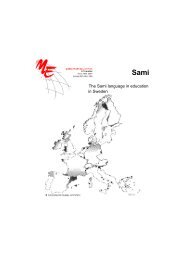Multilingual Early Language Transmission (MELT) - Mercator ...
Multilingual Early Language Transmission (MELT) - Mercator ...
Multilingual Early Language Transmission (MELT) - Mercator ...
You also want an ePaper? Increase the reach of your titles
YUMPU automatically turns print PDFs into web optimized ePapers that Google loves.
described nineteen years of his bilingual family, his children’s bilingual language (English-<br />
French) and literacy development in a monolingual setting (Louisiana in the US). In de 1980s<br />
the focus was on language choice and morphosyntactic development: the development (in<br />
young children) of the ability to construct words and sentences in the two languages. The<br />
starting point of research was the relationship between the two languages. More and more<br />
research is done into early bilingual language learning. For example, phonological<br />
development and early speech perception in bilingual infants (Bosch & Sebastián-Gallés,<br />
1997).<br />
More research is done concerning another line of research concerns the different domains<br />
of language learning. Cummins (2000: 57-111) distinguishes two levels of language learning<br />
skills: BICS (Basic Interpersonal Communication Skills) and CALP (Cognitive Academic<br />
<strong>Language</strong> Proficiency). BICS are language skills needed in social situations, and CALP refers to<br />
formal academic learning. This includes listening, speaking, reading, and writing about<br />
subject area content material. This level of language learning is essential for students to<br />
succeed in school.<br />
Since the 1990s about early bilingual development has been studied extensively. De Houwer<br />
(2009) remarks that: “There is simply too much of it, it is impossible to give a comprehensive<br />
review of most publicly available research on early bilingual acquisition” (De Houwer, 2009:<br />
13).<br />
Based on extensive research results, a large body of research suggests that bilingualism is<br />
good for an individual child’s linguistic development as well as for a child’s flexibility in<br />
intellectual and social<br />
processes.<br />
However, language is not an abstract vehicle but an instrument of human communication<br />
that needs to be used and further developed in two areas of language use. First, in the area<br />
of spontaneous communication between adults and children in the personal context of the<br />
family, the social environment of the work place, associations, sport activities, and cultural<br />
affairs. Second, by means of the training of the structures and expression of more abstract<br />
thinking processes. The older a person gets, the more abstract thinking is developed.<br />
Today the number of and also the geographic diversity of the researchers studying BFLA has<br />
grown. Western Europe was the first continent that investigated BFLA; nowadays<br />
researchers are active across the world: Northern America, Australia, China, and Russia. That<br />
brings specific cultural issues into research design, in the sense that children across the<br />
world have not got the same socio-psychological development. When children grow older,<br />
different events in their lives can lead them to acquire an additional second or third<br />
language. Grosjean (2010) suggests that there are probably more bilinguals on earth today<br />
than monolinguals. Due to immigration and globalisation the number of bi- and multilingual<br />
and bi- and multicultural individuals will only increase.<br />
In a couple of decades, the perspective of BFLA has reversed: first monolingualism was the<br />
norm and multilingualism the exception, nowadays multilingualism is the norm and<br />
monolingualism the exception.<br />
60



